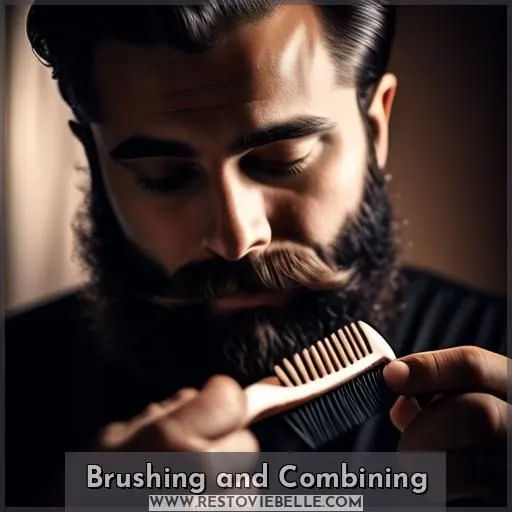This site is supported by our readers. We may earn a commission, at no cost to you, if you purchase through links.

You can train your beard to grow straight by being consistent with a proper grooming routine.
Start by brushing and combing your facial hair daily to train the hairs in the desired direction.
Use a boar bristle brush and quality beard comb.
Apply a beard oil or balm to soften coarse strands and promote manageability.
As your beard gains length, trimming and shaping the edges will help refine the overall look.
With patience and the right techniques, you’ll achieve a well-groomed, refined beard envied by many.
But mastering these skills takes time – keep going to realize the full potential.
Table Of Contents
- Key Takeaways
- How to Train Your Beard to Grow Straight?
- Reasons for Beard Hairs Sticking Out
- Genetics and Beard Growth
- Awkward Growth Phases
- Insufficient Length
- Improper Care Routine
- Infrequent or Excessive Trimming
- Weather Conditions
- Beard Training Techniques
- Brushing and Combining
- Beard Grooming Products
- Conclusion
Key Takeaways
- Start with a proper grooming routine, including daily brushing and combing, using a boar bristle brush and quality beard comb, and applying beard oil or balm.
- Genetics and growth phases play a role in beard growth, but consistent training and a proper care routine can help overcome challenges.
- A proper care routine and grooming are essential for maintaining a well-groomed beard, including washing with beard wash, using beard oil, and brushing daily.
- Consistency and patience are key to achieving a well-groomed, refined beard.
How to Train Your Beard to Grow Straight?
To train your beard to grow straight, follow these steps:
- Moisturize: Keep your beard soft and moisturized by washing it daily with a gentle cleanser and using a moisturizer after exfoliating.
- Brush Regularly: Brush your beard downwards while using your fingers to align the hairs for a straighter appearance. Regular brushing also stimulates the hair follicles, promoting healthier and faster beard growth.
- Use a Blow Dryer: On low heat, use a blow dryer to straighten your beard hair. Keep it at least three inches away from your face to avoid burning or damaging your facial hair and skin.
- Heated Beard Brush or Flat Iron: For a more permanent solution, use a heated brush or flat iron to straighten curly beard hair. Be sure to apply beard oil before using heated devices and use a low heat setting to avoid damaging your facial hair.
- Trim Regularly: Regularly trim your beard to keep it looking neat and straight. Use a quality trimmer with multiple settings to achieve a uniform look.
- Patience: Be patient with your beard growth. Age and genetics play a significant role in beard growth, so give it time to fill in.
Reasons for Beard Hairs Sticking Out
You’re tired of those pesky beard hairs sticking out, making your look disheveled.
Fortunately, with the right knowledge and techniques, you can tame those wild strands and achieve a clean, polished beard style.
Factors like genetics, growth phases, and grooming habits all play a role in determining how your beard grows.
However, consistent training and a proper care routine can help you overcome these challenges.
Genetics and growth phases
Genetics play a significant role in dictating the course of your beard growth. The contours of your face, the density of your facial hair, and the angle of your hair follicles are all influenced by your genetic makeup. Additionally, hormonal factors such as testosterone and its derivative dihydrotestosterone (DHT) bind to androgen receptors in your beard follicles, activating and fueling the growth process. However, everyone responds to these hormones differently, which is why genetics also play a vital role in your beard’s growth patterns.
During the awkward growth phase, which typically occurs between months 3 and 6, your beard may appear unruly or unkempt due to its in-between state. It’s longer than stubble but not quite long enough to style effectively, leading to an awkward appearance. This phase can be navigated with the assistance of beard balms, which provide hold to tame rebellious hairs and guarantee the beard retains its moisture, keeping it soft and manageable.
As your beard grows, it may fill in unevenly, with sporadic patches that lessen over time, giving way to a denser, more uniform growth. By the end of the third month, the beard starts to exhibit a more defined shape.
Proper care routine and grooming
Proper care routine and grooming are essential for maintaining a well-groomed beard.
Start by washing your beard with beard wash and avoiding regular shampoo and blow-drying.
Apply beard oil to a damp beard and rub into hairs and skin, but avoid overuse.
Brush your beard downward with a wild boar bristle brush daily to distribute oil evenly and prevent snagging.
Use beard balm for a great scent and light hold.
Follow a daily grooming regime to achieve desired results.
Consistency and persistence
You know the drill: consistency is key. Your beard’s no different. Stick to your guns with a dedicated grooming ritual, and patience will pay off. Keep the faith, your facial hair masterpiece is just a daily routine away.
- Embrace the grind; consistency shapes champions.
- Fuel your motivation; visualize the perfect beard.
- Weave beard training into your daily tapestry.
- Invest in dedicated grooming; reap a well-tamed mane.
- Patience is a virtue, especially in beard mastery.
Genetics and Beard Growth
Just as a master painter knows his brushes, you must know the tools of your trade: your genetics.
They’re the blueprint of your beard’s potential, dictating follicle angle, thickness, and texture.
Embrace the hand you’re dealt; whether it’s a thick lumberjack or a refined goatee, your genes lay the groundwork.
But fear not, with the right beard grooming, even the wildest of manes can be tamed.
So, let’s embark on the genetic lottery and sculpt your facial masterpiece to its finest.
Awkward Growth Phases
During the awkward growth phase, beard hairs can appear unruly and difficult to manage. This stage typically lasts for 2-3 weeks and is a natural part of the beard growth process. Here are four tips to help you navigate this phase:
- Be patient: The awkward growth phase is temporary, and your beard will eventually fill out. Avoid trimming or shaping your beard during this stage, as it can slow down overall growth.
- Maintain hygiene: Keep your beard clean by washing it regularly with warm water and using a gentle beard oil to keep it soft and healthy-looking.
- Use beard oils and brushes: Apply beard oil to your beard to ease itching and keep it soft. Use a beard brush to help distribute the oil evenly and train your beard hairs to grow in the right direction.
- Embrace the process: Remember that everyone’s beard growth is unique, and it’s normal for beard hairs to grow at different rates and patterns. Focus on maintaining good hygiene and patience, and your beard will eventually fill out and look more even.
Insufficient Length
Insufficient length is a common issue faced by many beard growers. During the early growth stage of beard development, your facial hair may appear patchy and uneven, with some areas having more dense growth than others. This can be attributed to the fact that not all hair follicles grow at the same rate. As your beard grows, it may also become more visible and start to concentrate in certain areas.
To address insufficient length, it’s important to maintain a balanced diet rich in vitamins, especially B vitamins, proteins, and omega-3 fatty acids, which can greatly improve your beard’s health and growth rate. Staying hydrated is also important for beard growth, as it ensures that your body can efficiently transport essential nutrients to your hair follicles. Regular exercise can increase blood circulation, boosting hair follicle growth. Sleep is critical for beard growth, as it’s during this time that your body repairs and regrows tissues, including your beard.
In addition to these factors, proper beard care is important for maintaining beard length. This includes regular trimming to remove split ends and damaged hair, which can help maintain your beard’s shape and appearance. Using beard oil can provide essential moisture to your facial hair and skin, promoting healthy growth while preventing dryness and itchiness. Regularly brushing your beard downward towards the chin can help distribute natural oils and encourage healthy growth.
Consistency is key with regard to beard maintenance. Daily combing or brushing can help tame fly-aways and baby hairs, ensuring that your beard stays neat and well-groomed. Using a strong brush for a few strokes a day can also help train your beard to grow in the right direction.
Improper Care Routine
Improper care routine can lead to beard hairs sticking out.
Start by incorporating beard wash into your daily routine to cleanse your facial hair and pores.
Opt for beard-specific products to avoid damaging your beard.
Consistently apply beard oil to hydrate and style your beard, focusing on the downward direction for best results.
Use beard waxes to tame flyaways and baby hairs.
Maintain a balanced approach to growth and trimming.
Infrequent or Excessive Trimming
Infrequent or excessive trimming can have a significant impact on the appearance and health of your beard. Trimming your beard too often or not enough can lead to uneven growth, split ends, and a lack of control over the overall style and shape of your facial hair. Here are some key points to keep in mind regarding trimming frequency and consistency:
- Trimming Frequency: Regular trimming is essential to maintain the desired style and shape of your beard. The frequency of trimming depends on your beard’s growth rate and the style you want to achieve. For most men, trimming once a week or every two weeks is sufficient to keep the beard tidy and eliminate split ends.
- Consistency: Consistency is vital when it comes to beard trimming. Adhering to a regular trimming schedule helps promote healthy hair growth and prevents the beard from becoming unruly or difficult to manage.
- Beard Styles: Different beard styles require varying levels of trimming. For example, a full beard may require more frequent trimming to maintain its shape, while a stubble beard may only need occasional touch-ups.
- Hair Care and Styling: Trimming is an essential part of beard care, as it helps distribute oils evenly and prevent tangles. It also allows you to style your beard according to your preferences.
- Hair Thickness: Trimming doesn’t affect the thickness of your hair. It only helps maintain a fresh and even look, getting rid of split ends and promoting healthier hair growth.
Weather Conditions
Weather conditions can profoundly affect the appearance and well-being of your beard.
During humid weather, your beard may become dry and brittle due to the elevated moisture in the air, causing frizz and making it more vulnerable to breakage.
In colder months, the diminished blood flow to the hair follicles can result in slower beard growth and potentially a sparser appearance.
Additionally, the lack of humidity in winter can cause your beard to become dry, brittle, and more susceptible to breakage.
To counteract these effects, it’s crucial to maintain adequate hydration by applying beard oil and balm more frequently during humid and cold weather.
Regular trimming can also help in managing split ends and maintaining a well-groomed appearance.
Beard Training Techniques
After addressing the vagaries of weather on your whiskers, let’s delve into the science of beard training methodologies. Perfecting beard growth direction isn’t merely about subduing the untamed; it’s about molding your unique appearance. Here’s how to navigate your stubble:
- Beard Alignment: As a captain guiding a ship, direct your facial hair growth toward the destination of your choice.
- Beard Shaping: Refine your scruff with precision, transforming rugged edges into a work of art.
- Beard Softening: Tame the whiskers of your facial fleet, making mustache grooming and care effortless.
Brushing and Combining
Brushing and combining are essential techniques for training your beard to grow straight and maintaining its health. A boar bristle brush is an excellent tool for this purpose, as it collects and redistributes natural oils throughout your beard, promoting less dryness, itchiness, and frizz. The bristles of a boar bristle brush absorb the human sebaceous oils from your pores and redistribute them, giving your hairs a natural shine** without weighing them down.
When brushing your beard, use a boar bristle brush daily to distribute the oils evenly and stimulate blood flow to your hair follicles, promoting healthy growth. Brush downward in the direction you want your beard to grow, as this helps to shape and style your beard. For stubborn hairs, use a saw-cut comb for shorter beards or a boar bristle brush for longer beards.
In addition to brushing, consider using beard balms and oils to hydrate and style your beard. Apply these products in a downward rubbing motion to enhance their effectiveness. Consistency is key, as regular brushing and grooming will help your beard grow in the right direction and maintain its health.
Beard Grooming Products
To tame your beard and achieve the desired straightness, you’ll need the right beard grooming products. Here are three essential items to contemplate:
- Beard Straightening Products: These formulas help manage curly or frizzy hairs, ensuring a well-groomed appearance.
- Beard Softening Products: Soften your beard with oils and balms, making it easier to style and manage.
- Beard Shaping Tools: Use combs and brushes to train your beard to grow in the right direction, enhancing your overall style and grooming routine.
Conclusion
Grooming is no different than training a stubborn pet—with patience and the proper techniques, even the most unruly beard hairs submit.
Persevere through taming those wild whiskers; keep brushing, combing, oiling, and shaping.
Consistency is key when learning how to train your beard to grow straight.
Each day’s effort sculpts those manly manes into refined, envied masterpieces—tangible proof you have conquered fuzziness.















